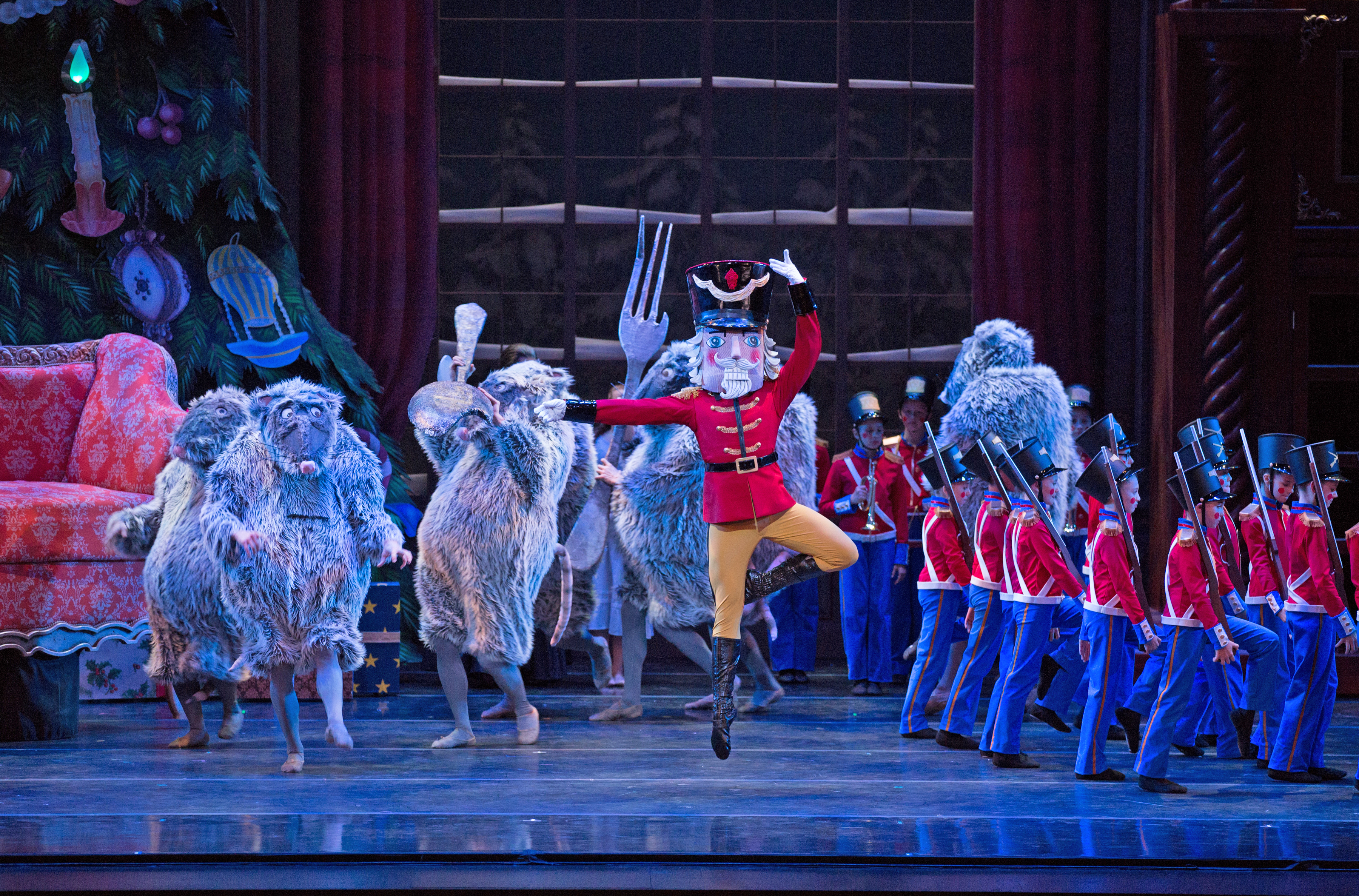IN REVIEW: KCB Opens Season with Ambitious ‘Carmina,’ Two Other Works
So far the performances we’ve seen in this second Kauffman Center season have made it clear that the wildly successful first season was not a fluke: The sheer grandeur of the place seems to be spurring local performing arts groups to ambitious new heights. I call it the “Kauffman effect,” as performers in a world-class facility just naturally strive to put world-class art on its stages. On October 12th it was the Kansas City Ballet’s turn, as it opened its new season with a sonically and visually dazzling Carmina Burana featuring three choruses, vocal soloists and the Kansas City Symphony Ballet Orchestra in the Muriel Kauffman Theatre pit, in richly detailed choreography by Toni Pimble of Eugene Ballet Company in Oregon. Dozens of choreographers have tried their hand at Carmina, but rarely is the work used in its hour-long entirety. Toni strives to achieve this ambitious task by creating clear narratives throughout that are directly related to those in the Medieval texts – poems of piety, love, rabble-rousing.
In addition to the expanded KCB company of 28 dancers (up from 25), an onstage chorus of 24 singers interacted with the dancers in such complex fashion that it made you wonder how on earth they managed to do it all. But for the most part it was the dancers who led the narrative, and though the texts to the songs were provided in the program there was simply no time (and not nearly enough light) to refer to them. (I would have loved to see the texts projected onto the Kauffman’s back-of-the-seat title system.) One was struck by how many new faces were seen among the dancers – 10 in all counting two apprentices.The in-your-face opening “O fortuna” grabs you right away, with somber, robed monks surrounding a dramatically top-lit Logan Pachciarz dipping and leaping and writhing at center stage; meanwhile the choirs and orchestra led by music director Ramona Pansegrau create a sonic wall of multiphonic sound. Dancer Yoshiya Sakurai is pinned like a butterfly to a rotating sort of stained-glass-window wheel. Unfortunately the space limitations made themselves apparent immediately: The necessity of putting the main choir in the front parterre boxes meant that they couldn’t hear each other very well. Nevertheless after some pretty out-of-sync singing they settled into a more reasonable sound.
In the heavily costumed “On the Green” section, Molly Wagner was playfully domineering of her three male companions (Michael Davis, Ian Poulis and Josh Spell), and Angelina Sansone was fresh and limpid for “Omnia sol temperat” with its paean to the onset of spring. Baritone Chris Carr sang with impressive warmth and gravitas throughout. The trio of ladies in “Chramer, gip die varwe mir” (Sarah Chun, Kaleena Burks and Arielle Espie) beautifully conveyed the humorously seductive text. (Casts vary.) In the Round Dance, a small circle of dancers rotated in the opposite direction of the outer circle, while the onstage chorus mingled and sang. In general, for the large-scale scenes throughout her Carmina Toni found ways of creating symmetrical patterns in what might otherwise look like an overcrowded stage, at times even placing the singers in the center and the dancers on the outsides.
In the raucous “In the Tavern” Chris Carr again conveyed a range of tumultuous emotions, while the men of the company wept and fought and drank. Tenor Casey Finnegan lent poignancy to “Olim Lacus,” and Geoffrey Kropp was exceptional in the text-heavy “In Taberna,” which he and eight men danced with vigor and touches of humor. In the “Court of Love” section we got to hear the clear-voiced soprano Sarah Tannehill, singing texts of love and passion and heartache. Molly and Logan floated fluidly through the sensuous “Si puer cum,” and Rachel Coats and Anthony Krutzkamp slithered amorously through “In trutina” and “Dulcissime” with Sarah singing its juicy poetry of “lascivious love and modesty.” Carmina ended as it began, with Yoshiya again on the “wheel” and Logan assertively reprising the opening. By the end I was exhausted: It almost seemed too much to take in, at least at a first look; one began to understand why so many choreographers choose not to set the entire piece. Still, Toni’sCarmina is an impressive achievement, and one that put our local artists to the test.
Lynne Taylor-Corbett’s Mercury opened the program, and its spare simplicity and wit matched fittingly the Haydn symphonic movements to which it was set. Holly Hynes had dressed the dancers in vivid colors – orange, gold, turquoise – and lighting designer Kirk Bookman created an atmosphere of shifting colors that was at once bold and dreamy. Lynne plays on both thesturm und drang and the humorous aspects of Haydn’s music, as well as on the irregular rhythms and the comic silences punctuated by frenzied outbursts. In the opening of the first of five movements Tempe Ostergren and Logan were joined by eight dancers for a fierce but fairly straightforward balletic introduction. Movement 2 was a formal, beautiful duet with Jill Marlow en pointe and Anthony, who by design seemed both engaged and distant from her. Molly and Michael Davis danced next, in a gentle battle of the sexes that both honored and poked fun of the conventional pas de deux; this was expanded to three pairs in Movement 4. The finale was a virtuosic ensemble for the whole group, in which previous material was jumbled into a busy close that again grew from the “mercurial” nature of Haydn’s music.
Ben Stevenson’s brief End of Time, set to the poignant slow movement from Rachmaninoff’s Cello Sonata, was an added treat. With a backdrop of stars, cellist Susie Yang and pianist Ramona Pansegrau performed live far upstage right, while Angelina and Geoffrey danced an achingly elegiac duet. An imagining of the end of time, the piece deals in conflict and sadness, with strong purpose of design and explosive movements that include not just traditional partnering but, at one point, Geoffrey dragging Angelina across the floor – before their tender parting from each other and from the world.
The Kansas City Ballet’s season opener runs through October 21st at the Kauffman Center. For tickets call 816-931-2232 or go to kcballet.org.
Features

By Paul Horsley David Ludwig knows better than to attach a “back-story” to a piece irrevocably, although he has openly stated that his new Violin Concerto was inspired by his…

By Paul Horsley Each production of The Nutcracker is to some extent a balancing act between spectacle and dance. At best it seamlessly integrates the colors and stagecraft that keep…

By Paul Horsley The Lyric Opera of Kansas City deserves applause for taking on an opera in Czech for the first time in its history, but the opening performance of…






